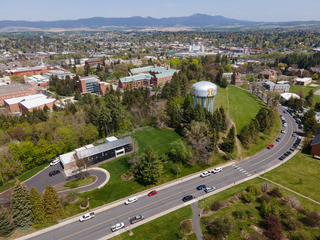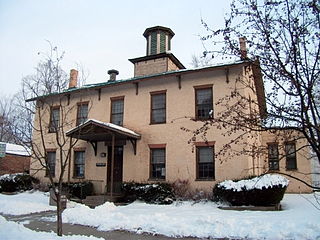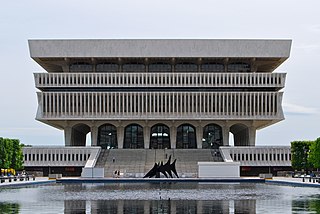
Hunter College is a public university in New York City, United States. It is one of the constituent colleges of the City University of New York and offers studies in more than one hundred undergraduate and postgraduate fields across five schools. It also administers Hunter College High School and Hunter College Elementary School.

The Tuscarora are an Indigenous Peoples of the Northeastern Woodlands in Canada and the United States. They are an Iroquoian Native American and First Nations people. The Tuscarora Nation, a federally recognized tribe, is based in New York, and the Tuscarora First Nation is one of the Six Nations of the Grand River in Ontario.

Moscow is a city and the county seat of Latah County, Idaho. Located in the North Central region of the state along the border with Washington, it had a population of 25,435 at the 2020 census. Moscow is the home of the University of Idaho, the state's land-grant institution and primary research university.

Lewiston is the second most populous city in the U.S. state of Maine, with the city's population at 37,121 as of the 2020 United States Census. The city lies halfway between Augusta, the state's capital, and Portland, the state's most populous city. It is one-half of the Lewiston–Auburn Metropolitan Statistical Area, commonly referred to as "L/A." or "L-A." Lewiston exerts a significant impact upon the diversity, religious variety, commerce, education, and economic power of Maine. It is known for having an overall low cost of living, substantial access to medical care, and a low violent-crime rate. In recent years, the city of Lewiston has also seen a spike in economic and social growth. While the dominant language spoken in the city is English, it is home to a significant Somali population as well as the largest French-speaking population in the United States while it is second to St. Martin Parish, Louisiana, in percentage of speakers.

Lee Oscar Lawrie was an American architectural sculptor and an important figure in the American sculpture scene preceding World War II. Over his long career of more than 300 commissions Lawrie's style evolved through Modern Gothic, to Beaux-Arts, Classicism, and, finally, into Moderne or Art Deco.

The Lansingburgh Academy was a seminary in Lansingburgh, New York. The seminary was in existence from the late 18th century to 1900, when the building that housed it was leased to the Lansingburgh School District. The building was sold to the school district in 1911. Initially used as a high school, the Lansingburgh Academy was eventually sold to the local library system; as of 2007, it served as the Lansingburgh Branch of the Troy Public Library. The Lansingburgh Academy was listed on the National Register of Historic Places in 1976.

The University of Birmingham is a public research university in Birmingham, England. It received its royal charter in 1900 as a successor to Queen's College, Birmingham, and Mason Science College, making it the first English civic or 'red brick' university to receive its own royal charter, and the first English unitary university. It is a founding member of both the Russell Group of British research universities and the international network of research universities, Universitas 21.

Lewiston is a village in Niagara County, New York, United States. The population was 2,701 at the 2010 census. The village is named after Morgan Lewis, an early 19th-century governor of New York. It is part of the Buffalo–Niagara Falls Metropolitan Statistical Area.

Lewiston is a town in Niagara County, New York, United States. The population was 15,944 at the 2020 census. The town and its contained village are named after Morgan Lewis, a governor of New York.

The New York State Library is a research library in Albany, New York, United States. It was established in 1818 to serve the state government of New York and is part of the New York State Education Department. The library is one of the largest in the world by number of items held, with over 20 million cataloged items in 2011.

The Mary Louis Academy, also known as TMLA, is an all-girls private Catholic college-preparatory academy, located in Jamaica Estates, Queens, New York City. TMLA's 5-acre (20,000 m2) campus encompasses eight buildings situated on private grounds at the top of one of the highest hills in Queens, hence TMLA's interscholastic nickname "The Hilltoppers".

Niagara-Wheatfield Central School District is a public school district in New York State located in the Town of Lewiston, New York, about 10 miles (16 km) from Niagara Falls, New York. The District serves students from the towns of Niagara and Wheatfield.

Tuscarora Heroes Monument is located in Lewiston, New York and stands as a testament of thanksgiving from the people of Lewiston to the Tuscarora Nation for saving the lives of dozens of local residents during the War of 1812 British attack on December 19, 1813. It consists of three 110% lifesize bronze sculptures that depict a tableau of two Tuscarora men rescuing a local woman and her baby from the British attack.

New Rochelle Public Library (NRPL) is a public library located in New Rochelle, New York. Chartered in 1894, the NRPL is a school-district library with its own operating budget and a board of trustees with seven elected members. The library has served the residents of New Rochelle from its main library building in the downtown business district since 1979.

Caroline Peddle Ball was an American sculptor. She exhibited at both the 1893 Chicago Exposition and the 1900 Paris Exhibition.
Elko was a town in Cattaraugus County, New York that existed from 1890 to 1965. It was forcibly evacuated in 1965 due to the construction of the Kinzua Dam on the Allegheny River in Warren County, Pennsylvania, one of the largest dams in the United States east of the Mississippi. The dam was authorized by the United States Congress as a flood control measure in the Flood Control Acts of 1936 and 1938, and was built by the U. S. Army Corps of Engineers beginning in 1960. Other benefits from the dam include drought control, hydroelectric power production, and recreation.

The history of Bates College began shortly before Bates College's founding on March 16, 1855, in Lewiston, Maine. The college was founded by Oren Burbank Cheney and Benjamin Bates. Originating as a Free Will Baptist institution, it has since secularized and established a liberal arts curriculum. After the mysterious 1853 burning of Parsonsfield Seminary, Cheney wanted to create another seminary in a more central part of Maine: Lewiston, a then-booming industrial economy. He met with religious and political leaders in Topsham, to discuss the formation of such a school, recruiting much of the college's first trustees, most notably Ebenezer Knowlton. After a well-received speech by Cheney, the group successfully petitioned the Maine State Legislature to establish the Maine State Seminary. At its founding it was the first coeducational college in New England. Soon after it was established, donors stepped forward to finance the seminary, developing the school in an affluent residential district of Lewiston. The college struggled to finance its operations after the financial crisis of 1857, requiring extra capital to remain afloat. Cheney's political activities attracted Benjamin Bates, who was interested in fostering his business interests in Maine. Bates donated installments of tens of thousands of dollars to the college to bring it out of the crisis.
The Lewiston Railroad Company was an early railroad in Lewiston, NY, running to Niagara Falls, NY. The railroad eventually became a part of the New York Central Railroad system.
Tuscarora is a hamlet and census-designated place in the town of Mount Morris, Livingston County, New York, United States. Its population was 74 as of the 2010 census.

















